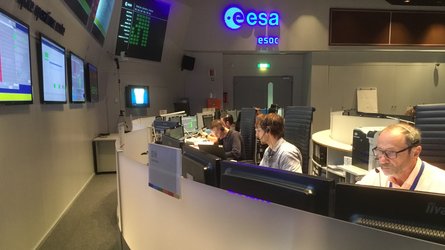Accept all cookies Accept only essential cookies See our Cookie Notice

About ESA
The European Space Agency (ESA) is Europe’s gateway to space. Its mission is to shape the development of Europe’s space capability and ensure that investment in space continues to deliver benefits to the citizens of Europe and the world.
Highlights
ESA - United space in Europe
This is ESA ESA facts Member States & Cooperating States Funding Director General Top management For Member State Delegations European vision European Space Policy ESA & EU Space Councils Responsibility & Sustainability Annual Report Calendar of meetings Corporate newsEstablishments & sites
ESA Headquarters ESA ESTEC ESA ESOC ESA ESRIN ESA EAC ESA ESAC Europe's Spaceport ESA ESEC ESA ECSAT Brussels Office Washington OfficeWorking with ESA
Business with ESA ESA Commercialisation Gateway Law at ESA Careers Cyber resilience at ESA IT at ESA Newsroom Partnerships Merchandising Licence Education Open Space Innovation Platform Integrity and Reporting Administrative Tribunal Health and SafetyMore about ESA
History ESA Historical Archives Exhibitions Publications Art & Culture ESA Merchandise Kids Diversity ESA Brand CentreLatest
Space in Member States
Find out more about space activities in our 23 Member States, and understand how ESA works together with their national agencies, institutions and organisations.
Science & Exploration
Exploring our Solar System and unlocking the secrets of the Universe
Go to topicAstronauts
Missions
Juice Euclid Webb Solar Orbiter BepiColombo Gaia ExoMars Cheops Exoplanet missions More missionsActivities
International Space Station Orion service module Gateway Concordia Caves & Pangaea BenefitsLatest
Space Safety
Protecting life and infrastructure on Earth and in orbit
Go to topicAsteroids
Asteroids and Planetary Defence Asteroid danger explained Flyeye telescope: asteroid detection Hera mission: asteroid deflection Near-Earth Object Coordination CentreSpace junk
About space debris Space debris by the numbers Space Environment Report In space refuelling, refurbishing and removingSafety from space
Clean Space ecodesign Zero Debris Technologies Space for Earth Supporting Sustainable DevelopmentLatest
Applications
Using space to benefit citizens and meet future challenges on Earth
Go to topicObserving the Earth
Observing the Earth Future EO Copernicus Meteorology Space for our climate Satellite missionsCommercialisation
ESA Commercialisation Gateway Open Space Innovation Platform Business Incubation ESA Space SolutionsLatest
Enabling & Support
Making space accessible and developing the technologies for the future
Go to topicBuilding missions
Space Engineering and Technology Test centre Laboratories Concurrent Design Facility Preparing for the future Shaping the Future Discovery and Preparation Advanced Concepts TeamSpace transportation
Space Transportation Ariane Vega Space Rider Future space transportation Boost! Europe's Spaceport Launches from Europe's Spaceport from 2012Latest

One word: Tradition!
Thank you for liking
You have already liked this page, you can only like it once!
On 31 May, the joint ESA/CNES mission control team gathered in the Main Control Room at ESA’s European Space Operations Centre (ESOC), in Darmstadt, Germany, to celebrate the completion of the eight-day initial orbit phase for Galileo satellites 13 and 14.
The pair lifted off together at 08:48 GMT (10:48 CEST, 05:48 local time) on 24 May atop a Soyuz rocket from French Guiana. This seventh Galileo launch went by the book, and brought Europe’s Galileo constellation half way to completion.
As soon as they separated from their launcher, the pair were brought under control by the joint team, which worked round-the-clock shifts to check out the satellites’ systems, test basic functionality and conduct a series of thruster burns to fine tune their orbits.
On 31 May and 1 June, the satellites were successively handed over to the Galileo Control Centre near Munich for further commissioning and transition into routine operations.
As is traditional at ESOC, the mission name was added to history wall to mark successful completion of the launch and early operations phase.
For almost 50 years, the ESOC has been home to highly specialised teams that control and navigate spacecraft, manage ESA’s worldwide ground tracking station network, and build the complex ground systems that enable satellites to conduct their missions.
Since inception in 1967, teams at ESOC have launched 76 spacecraft, of which 51 were then taken over for operation through their complete mission.
Currently, engineers operate 13 missions comprising 19 satellites from ESOC, while experts from ESA’s Operations directorate also control three Proba satellites from Redu Centre, Belgium.
More information
-
CREDIT
ESA/R. Palmari -
LICENCE
ESA Standard Licence

Galileo control room

ESOC Control Room

Venus Express controllers in ESOC Main Control Room

ESOC teams complete BepiColombo dress rehearsal















 Germany
Germany
 Austria
Austria
 Belgium
Belgium
 Denmark
Denmark
 Spain
Spain
 Estonia
Estonia
 Finland
Finland
 France
France
 Greece
Greece
 Hungary
Hungary
 Ireland
Ireland
 Italy
Italy
 Luxembourg
Luxembourg
 Norway
Norway
 The Netherlands
The Netherlands
 Poland
Poland
 Portugal
Portugal
 Czechia
Czechia
 Romania
Romania
 United Kingdom
United Kingdom
 Slovenia
Slovenia
 Sweden
Sweden
 Switzerland
Switzerland

























